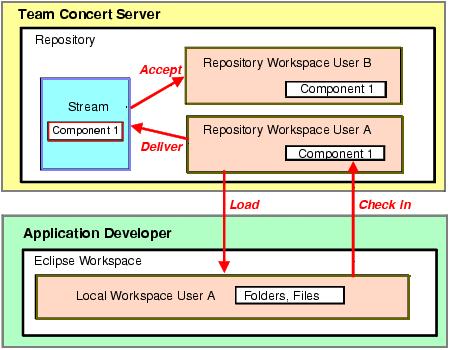Optional components
The optional components are listed next.
Work items
Each process defines categories of work items that can be assigned to team member, worked on, and queried. Each work item type has a state transition model that defines the available states and the actions that users can take to move a work item from one state to another.
Some types of work items, such as Defect or Enhancement are suitable for being associated to source code change sets. Other types of work items, such as Retrospective (in the Eclipse way and Agile processes), are used to record what went well and what did not go well in the recently completed iteration, and so forth.
Agile planning
The Agile planning component allows team leads and members to create iteration plans and to distribute work items to them according to the chosen process.
The source control component is based on repository workspaces, and streams. Team Concert bases source control on change sets, not on files. Change sets contain the before and after states of versionable items, an optional comment, and can be linked to a work item.
In Application Developer (and in Eclipse) there is a local workspace, contained in the Eclipse workspace, which mirrors the repository workspace of that particular user. A repository workspace is similar to an Application Developer or Eclipse workspace because it contains the artifacts developed by one particular user, but it is very different because it is stored in the repository, on the Team Concert server.

| Change sets are pushed from the local workspace onto the repository workspace by the check in operation. Conversely, files can be imported into a local workspace from the repository workspace by using the load operation.
|

| The fact of having a repository workspace allows each user to make a backup of their work on the server. When a particular user is satisfied with the changes, the user can make them available to the team by using the deliver operation.
|

| Change sets are delivered from the repository workspace (which belongs to one user) to the stream (which belongs to a team).
|

| A stream holds a common shared copy of the files, and it is also stored on the server.
|

| A user can accept changes made by other team members and available in the stream change history. Each workspace or stream keeps a change history that permits to creation of the current version of the items from the accumulated changes.
|
In complex projects, streams and workspaces can be partitioned into components that have their own change history, change sets and configuration .
To initialize streams and workspaces, it is possible to create a baseline, which is an immutable copy of a component in a given workspace or stream. A snapshot is an immutable collection of one baseline for each workspace component, which can be used to recreate the entire workspace configuration (typically for reproducing a build).

Figure 29-2 Local and Workspace Repository and their relationship to a Stream
Team build
Team Concert includes the Jazz Build Engine and an Ant Build Toolkit that can publish build information to the Jazz repository. The repository contains:

| Build definition items, representing a particular build, such as a weekly project-wide integration build;
|

| Build engine items, representing a particular build system running on a build server;
|

| Build request items, representing a particular request to run a build;
|

| Build result items, representing the outputs from a particular run.
|
The installation of Team Concert provides two components: Jazz Build Engine and Build Toolkit.

| The Jazz Build Engine can be used to run continuous builds or to request builds at a particular point in time. While the build items described before are optimized for use with the Jazz Build Engine, they can also be used with other build engines such IBM Rational BuildForge or CruiseControl.
|

| The Build Toolkit is a set of Ant Tasks that can be used to perform the following tasks:
|

 Publishing build results and contributions
Publishing build results and contributions
|

 Enabling progress monitoring
Enabling progress monitoring
|

 Controlling the build life cycle
Controlling the build life cycle
|
There are four types of available build templates that can be selected when creating a new build definition:
| Ant - Jazz Build Engine A build using Ant and the Jazz Build Engine
|
| Command Line - Jazz Build Engine A build that invokes a command line using the Jazz Build Engine
|
| Maven - Jazz Build Engine A build using Maven 2 and the Jazz Build Engine
|
Team reports
The reports component applies only to the Standard edition and it consists of the data warehouse and the reports engine. The data warehouse stores read-only snapshots of the repository data in a non-normalized form that is optimized for efficient queries and quick response times. The report engine is based on the Eclipse BIRT (Business Intelligence and Reporting Tools) project.













 Publishing build results and contributions
Publishing build results and contributions

 Enabling progress monitoring
Enabling progress monitoring

 Working with Jazz source control
Working with Jazz source control

 Controlling the build life cycle
Controlling the build life cycle